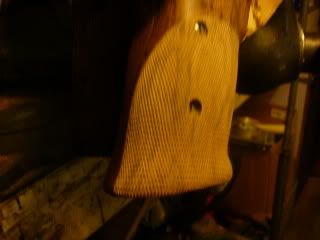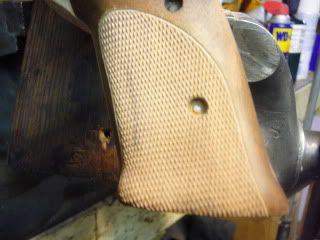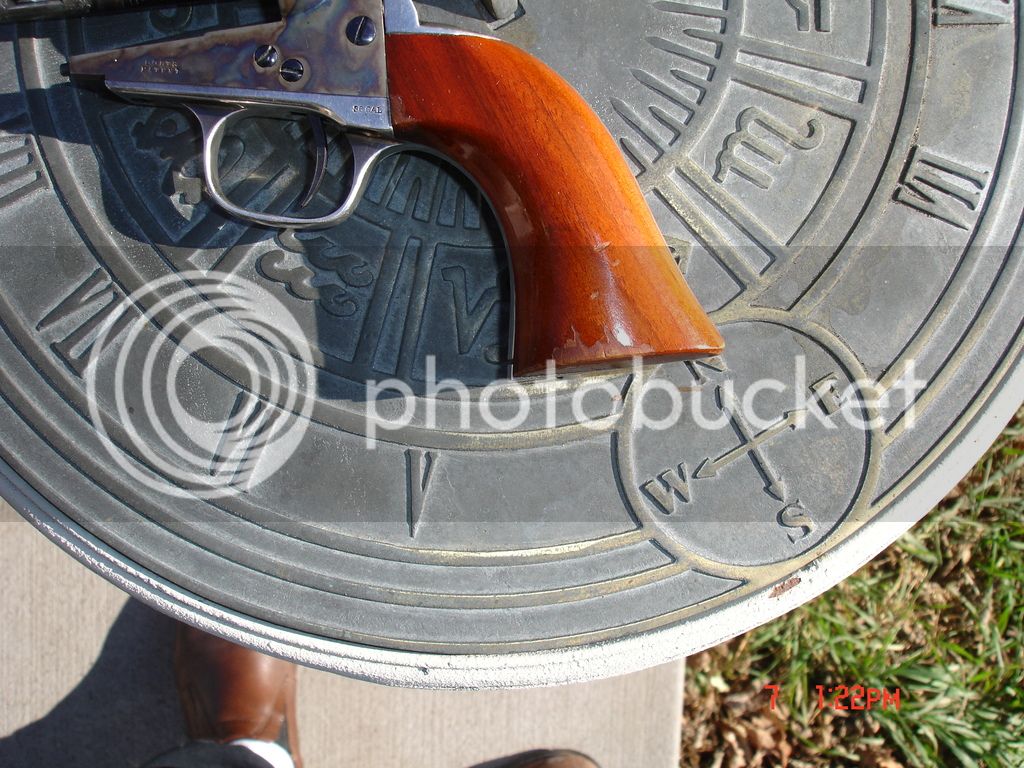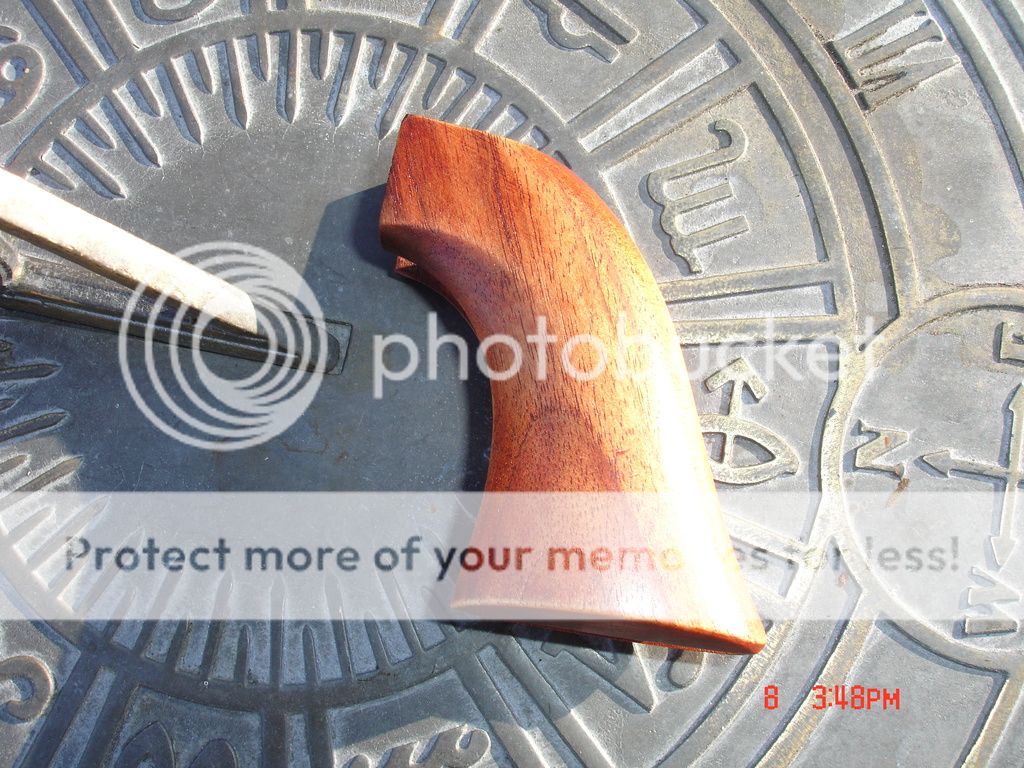-
This community needs YOUR help today. We rely 100% on Supporting Memberships to fund our efforts. With the ever increasing fees of everything, we need help. We need more Supporting Members, today. Please invest back into this community. I will ship a few decals too in addition to all the account perks you get.

Sign up here: https://www.muzzleloadingforum.com/account/upgrades -
Friends, our 2nd Amendment rights are always under attack and the NRA has been a constant for decades in helping fight that fight.
We have partnered with the NRA to offer you a discount on membership and Muzzleloading Forum gets a small percentage too of each membership, so you are supporting both the NRA and us.
Use this link to sign up please; https://membership.nra.org/recruiters/join/XR045103
You are using an out of date browser. It may not display this or other websites correctly.
You should upgrade or use an alternative browser.
You should upgrade or use an alternative browser.
Wood Grip Finish On Colts
- Thread starter Eric N.
- Start date

Help Support Muzzleloading Forum:
This site may earn a commission from merchant affiliate
links, including eBay, Amazon, and others.
- Joined
- Jun 4, 2014
- Messages
- 3,936
- Reaction score
- 4,710
My guess(and its just a guess) would be they would be oil finished, like with boiled linseed oil.
BLO is available at your local Home Depot, Lowes or friendly family hardware store, in the paint section.
BLO is available at your local Home Depot, Lowes or friendly family hardware store, in the paint section.
Gunstocks of the 19th Century, both long guns and hand guns generally used one of two types of varnish finishes:
1) Real boiled (heat polymerized) oil varnish
You can make your own (let me know and I'll try and post the how-to) for the closest match; use Tried and True's Varnish Oil (IMO second best); Tru-Oil gunstock finish
2) Or some type of spirit varnish which often included a coloring agent. I've only made my own based on original recipes, but prefer the Rela stuff as noted above
1) Real boiled (heat polymerized) oil varnish
You can make your own (let me know and I'll try and post the how-to) for the closest match; use Tried and True's Varnish Oil (IMO second best); Tru-Oil gunstock finish
2) Or some type of spirit varnish which often included a coloring agent. I've only made my own based on original recipes, but prefer the Rela stuff as noted above
- Joined
- Jun 4, 2014
- Messages
- 3,936
- Reaction score
- 4,710
Last edited by a moderator:
- Joined
- Dec 25, 2011
- Messages
- 8,777
- Reaction score
- 3,759
One of the newer finishes I have been experimenting with on a few pistol grips I have made is after final sanding, seal them with thinned heated epoxy.
It can be had in thinned versions and when worked in with a heat gun it will really penetrate the wood.
Then when cured knock it back and apply a good six coats of hand rubbed True oil for the final finish and it will look just like a traditional oil finish but will resist water like crazy.
It also works really good for holding the points when you checker the grip panels.
Course after you checker you need to work back in some more epoxy to seal up the wood before using the True-Oil. I do this with a stiff tooth brush.
Ready to seal the checkering with epoxy before the True oil build up.

Sealed up , ready for the Tru-oil.

It can be had in thinned versions and when worked in with a heat gun it will really penetrate the wood.
Then when cured knock it back and apply a good six coats of hand rubbed True oil for the final finish and it will look just like a traditional oil finish but will resist water like crazy.
It also works really good for holding the points when you checker the grip panels.
Course after you checker you need to work back in some more epoxy to seal up the wood before using the True-Oil. I do this with a stiff tooth brush.
Ready to seal the checkering with epoxy before the True oil build up.

Sealed up , ready for the Tru-oil.

Those are gorgeous!
- Joined
- Dec 25, 2011
- Messages
- 8,777
- Reaction score
- 3,759
Thanks, I borrowed the shape idea from some commercial grips I bought for another pistol that do not quite fit my hand as well as they could so made these out of some scrap walnut I had left over. These fit my hand very well.
The thinned epoxy seal is also a borrowed idea I read about and decided made sense and was worth a try.
I like it a lot and plan on using it on more stock and grip projects in the future.
It is messy though and one has to work fast to get it to penetrate before it kicks over and begins to harden.
The thinned epoxy seal is also a borrowed idea I read about and decided made sense and was worth a try.
I like it a lot and plan on using it on more stock and grip projects in the future.
It is messy though and one has to work fast to get it to penetrate before it kicks over and begins to harden.
Looking at the photo of, Colt No. 1022 and Colt No. 120 in R.L.Wilson's fine book,Eric N. said:I have an 1848 Whitneyville/Hartford Uberti that I want to look like the originals. I am taking the bluing off the cylinder,but what did the stocks look like? Thanks.
"C*O*L*T
AN AMERICAN LEGEND"
both guns seem to have oiled grips (pp 24,25).
Apparently, rubbed in linseed oil was used on the walnut grips.
This would fit with the situation as the guns were made by Ely Whitney Jr.'s company, a firm known to cut corners and use the most inexpensive materials in the products they made.
The pores in the walnut seem to have been filled, probably by sanding them with sandpaper and linseed oil (a technique often used to fill walnut , both then and today).
- Joined
- May 6, 2014
- Messages
- 16,892
- Reaction score
- 15,305
FWIW, it seems most collectors believe the Military Contract Colt BP revolver grips were low sheen oil finished, while the models sold to civilians were varnished.
Gus
Gus
Billnpatti
Cannon
- Joined
- Aug 11, 2008
- Messages
- 7,340
- Reaction score
- 39
I haven't tried using thinned epoxy but I have used low luster urethane varnish thinned 1:1 with mineral spirits and worked into the checkering with a stiff toothbrush. When I have used it on smooth gun stocks, I apply it thinly with my finger tips and thoroughly rub it in with the heel of my hand like you would Tru-Oil. It looks much like a BLO finish but with much more protection. I have given some of my stocks a final finish with a good rub with Birchwood Casey's "Stock Sheen". It yields a gorgeous satin finish reminiscent of some of the fine English gun stocks. Not necessarily HC but gorgeous none the less. Just the ramblings of an old fart. :haha:
- Joined
- Dec 25, 2011
- Messages
- 8,777
- Reaction score
- 3,759
Yup, I've used the urethane as well Bill and it does nearly as good a job as the epoxy at sealing out water from what I've seen and is a heck of a lot easier to use.
Thanks for adding to the conversation with some good stuff!
Thanks for adding to the conversation with some good stuff!
Col. Batguano
75 Cal.
- Joined
- Feb 10, 2011
- Messages
- 5,034
- Reaction score
- 1,406
Go look at the James D. Julia recently concluded auction. There are lots and lots of very high finish originals in the catalog, including a couple of Pattersons.
- Joined
- Apr 10, 2012
- Messages
- 545
- Reaction score
- 256
You beat me to it. :applause: Yes, factory finish must be removed before anything else is tried. Those I have seen were very plastic-like. I think sanding is only method to remove. Then any good oil rubbed in will be good looking. I have tried a few and like the look and durability.
- Joined
- Mar 16, 2007
- Messages
- 542
- Reaction score
- 52
That looks very nice but I am a little surprised as I have never had any luck getting tung oil to dry. Tung oil finish is another story though, and I use it all the time.
- Joined
- Apr 10, 2012
- Messages
- 545
- Reaction score
- 256
I let it sit overnight rub them hard with an old t-shirt and do it again. There's only 5 coats on this one but I can do more any time I want to.
I just looked and it is Tung Oil Finish.
I just looked and it is Tung Oil Finish.
Tung oil finish has all sorts of things in it to make it dry fast.
Pure Tung oil dries about as fast as pure Linseed oil. In other words, it takes days or weeks to harden. At least that's been my experience with the Pure Tung oil I have.
Pure Tung oil dries about as fast as pure Linseed oil. In other words, it takes days or weeks to harden. At least that's been my experience with the Pure Tung oil I have.
Poor Private
58 Cal.
- Joined
- Feb 25, 2007
- Messages
- 2,073
- Reaction score
- 17
A few years ago my repop .58 cal Enfield that I use for civil war reenacting had a horrible looking finished stock. At the end of a season I finally decided to do something with it. Stripped all the poly finish off of it and started giving it coats of tung oil. It took forever( well all winter). Oil it down let it dry and give a light sanding and coat again. I think I have about 8 coats in that stock. I like the look much better and give it a light oiling when I think it needs it.
AZbpBurner
54 Cal.
Not sure why you're removing the blue on the cylinder, since originals were blued at the factory. With that in mind, if you want to fake up an old faux original beater, then just soak the grips in a quart of water with a TSP of bleach in it. It will better match your stripped cylinder. Nothing looks quite as perplexing as an old, beat to death-looking firearm with finely finished wood on it.
Similar threads
- Replies
- 25
- Views
- 1K
- Replies
- 21
- Views
- 592






